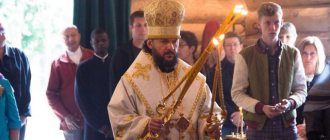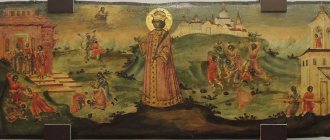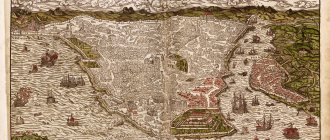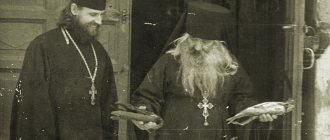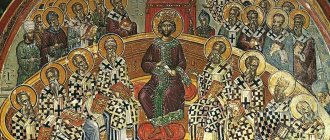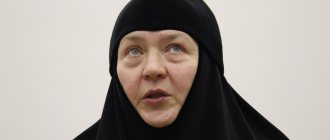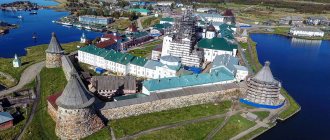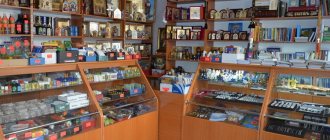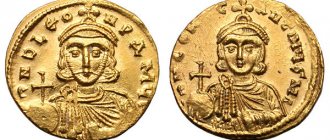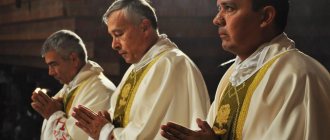| Greek Orthodox Church | |
Annunciation Cathedral in Athens | |
| basic information | |
| Founders | holy apostle paul |
| Autocephaly | proclaimed 1833, recognized by the Church of Constantinople on June 29, 1850 |
| Primate at present | Jerome II (Liapis) |
| Center | Athens, Greece |
| Residence of the Primate | Athens |
| Jurisdiction (territory) | Greece |
| Mother Church | Constantinople Orthodox Church |
| Liturgical language | Greek |
| Musical tradition | Byzantine |
| Calendar | New Julian[1] |
| Number | |
| Dioceses | 81 |
| Monasteries | 200 |
| Believers | 9 246 230 |
| Website | [www.ecclesia.gr/ www.ecclesia.gr] |
Hellas
(
Greek
)
Orthodox Church
(officially
the Church of Hellas
, Greek Ἐκκλησία τῆς Ἑλλάδος) - an autocephalous local Orthodox Church, having 11th place in the diptych of autocephalous local Churches; has state status. Currently follows the New Julian calendar.
Story
Historically, the Orthodox population of what is now Greece was within the jurisdiction of the Orthodox Church of Constantinople.
With independence in 1822 and the formation of the Kingdom of Greece in 1832, such a situation became politically impossible; in 1833, by decision of the Bavarian regents, on behalf of the young king Otto I, a special declaration of July 23 proclaimed the autocephaly of the Church in the territory of the kingdom. The king was declared the head of the Church. Such a unilateral declaration of jurisdictional independence, in violation of church law, was not recognized by the kyriarchal Church of Constantinople, as well as by other local Churches. A schism arose that lasted 17 years.
On June 29, 1850, by the tomos of Patriarch Anthimus IV, the Church in Hellas was recognized by the Ecumenical Patriarchate, which, however, recorded a number of conditions ensuring the special status of the “Mother Church” (Ecumenical Patriarchate) in Hellas.
In 1924, the church switched to the New Julian calendar, which caused protest among some parishioners and clergy.
On September 4, 1928, a joint agreement was drawn up between the Greek and Constantinople Churches regarding the 36 dioceses that ended up in Greece after the Treaty of Lausanne. According to the Patriarchal and Synodal Acts, the dioceses of the “new territories” (Epirus, South Macedonia, Western Thrace and most of the islands of the Aegean archipelago), formally remaining under the jurisdiction of the Patriarchate of Constantinople, became part of the Greek Church (that is, they were administratively subordinate to it), according to the already accepted state Greek Law No. 3615 of July 15, 1928[2].
In 1935, three bishops who actively protested against the new calendar announced the creation of the so-called “Church of True Orthodox Christians” (Greek: Εκκλησία των Γνησίων Ορθοδόξων Χριστιανών - Γ. Ο.Χ.). As a result, the Old Calendar movement (Greek: Παλαιοημερολογίτες), unrecognized by other Orthodox churches, took shape. Since the 1940s, the Old Calendarists began to split into smaller groups.
During World War II, the Church found itself in a difficult situation. First of all, it is necessary to replenish the ranks of the killed priests: there were about six hundred of them. The second problem: the restoration of destroyed churches. The Archbishop of Athens organized a collection of donations throughout Greece for this purpose[3].
Since 1949, the state has taken upon itself the financial care of the clergy. Seminary teachers and teachers of the Law of God in high schools are in the position of government officials; seminaries are also maintained at state expense[3].
Historical sketch
The Christian faith was brought to the territory of modern Greece (Hellas) by the Apostle Paul, who, during his second and third evangelistic journeys, founded and established Christian communities in a number of cities in Macedonia and Achaia. The Apostle John the Theologian wrote the book of Revelation on the island of Patmos. Since the century, the episcopal sees of Greece have been part of either the Roman or Constantinople Churches. In 1453, these lands were conquered by the Turks and came entirely under the jurisdiction of the Patriarchate of Constantinople. In 1830, Greece achieved political independence from the Ottoman Empire and began the struggle for autocephaly, which it received in 1850. According to the 1975 Constitution, the Church was separated from the state. Due to disputes about the calendar, the Greek Church in the century was struck by a chain of Old Calendar schisms.
Device and control
The highest authority in the Greek Church belongs to the Holy Synod of Hierarchs
(Ιερά Σύνοδο της Ιεραρχίας), which includes all diocesan bishops. The latter all have the title of metropolitan and are appointed by the government of the Republic. The Synod is headed by the Archbishop of Athens and All Greece (Αρχιεπίσκοπος Αθηνών και πάσης Ελλάδος), elected, according to the Statutory Charter of the Greek Church of 1977, by the Synod from among the Greeks serving metropolitans (diocesan bishops). Upon election, within 5 days, the President of Greece issues a decree on his recognition, after which the newly elected one is enthroned.
Permanent Holy Synod
(Διαρκής Ιερά Σύνοδος), dealing with day-to-day issues of church-wide administration, consists of the Archbishop and 12 metropolitans, each of whom holds the post of member of the Permanent Synod for one term on a rotating basis.
Statistics
- 1999 - 9025 thousand members [4]
- no later than January 1, 2006 - 10003.4 thousand members; 7756 parishes; 8335 clergy [5]
- December 31, 2010 - 9117 clergy [2]
- 2012 - approx. 557 monasteries (2012) [6]
- 2013 - about 8 million believers (out of more than 11 million of the total population of Greece), 81 metropolitanates, 105 bishops, 8,857 priests, about 8 thousand parishes, 4,087 monastics, 598 monasteries and monasteries (men's - 232, women's - 294 , monasteries - 72), 24,726 non-parish churches (cemeteries, prisons, etc.). There are 2,716 charitable foundations, 285 charitable canteens, 422 social institutions (kindergartens, youth camps, shelters) in the Greek Church [3]
- November 2015 - 10,500 priests were appointed to the church staff; due to state restrictions on ordinations, there is a shortage of priests - 2,300 people; 22% of parishes remain without pastoral care [7]
Current state
Includes 81 dioceses, 30 of which in Northern Greece and the large islands of the North (the so-called “New Territories”) are nominally under the jurisdiction of the Patriarch of Constantinople. 6 of the 12 metropolitans of the Permanent Synod represent the New Territories.
The dioceses of Crete and Dodecanese, as well as all the monasteries of Athos, are under the direct jurisdiction of the Patriarch of Constantinople and are not considered part of the Church of Greece.
Has 200 monasteries; has about 8 million members (out of 10.6 million of the total population of Greece).
As of December 31, 2010, the number of clergy in Greece was 10,368 people, of which 9,117 belonged to the jurisdiction of the Greek Orthodox Church, 1,007 to the Cretan Church, 228 to the metropolises of the Dodecanese Islands and 16 to the Patmos Exarchate, belonging to the Patriarchate of Constantinople.
Metropolises of the Greek Orthodox Church
- Metropolis of Alexandroupolis
- Argolid Metropolis
- Metropolis of Art
- Metropolis of Attica
- Archdiocese of Athens
- Vereian, Naussian and Kambanian Metropolis
- Gythian and Itil Metropolis
- Metropolis of Glyfada
- Metropolis of Gortyn and Megalopolis
- Greven Metropolis
- Gumenissiysk, Aksioupoli and Polikastronsky Metropolis
- Didymotikh and Orestiad Metropolis
- Dimitriad and Almyros Metropolis
- Metropolis of Drama
- Driinupol, Pogoniani and Konitsian Metropolises
- Zakynthos Metropolis
- Zikh and Nevrokopi Metropolis
- Hydra, Spet and Aegina Metropolis
- Ierisos, Holy Mountain and Ardamerion Metropolis
- Ili Metropolis
- Metropolis of Ioannina
- Metropolis of Kalavrita and Aegialia
- Karysti and Skyros Metropolis
- Karpenision Metropolis
- Metropolis of Cassandria
- Metropolis of Kastoria
- Metropolis of Corfu, Paxia and Diapontine Islands
- Metropolis of Caesarea, Virona and Ymittos
- Kefallinian Metropolis
- Metropolis of Kitros, Catherine and Platamon
- Kithira Metropolis
- Corinthian, Sicyonian, Zemenonian, Tarsus and Polyphengos Metropolises
- Metropolis of Xanthia and Peritheoria
- Archdiocese of Lankadas
- Metropolis of Larissa and Tyrnavos
- Levkas and Ifakia Metropolis
- Metropolis of Limnos and St. Eustratius
- Metropolis of Mantini and Kynuria
- Maroni and Comotini Metropolis
- Metropolis of Megara and Salamis
- Mesogean and Laureotic Metropolis
- Messinian Metropolis
- Metropolis of Mytilene, Eresos and Plomarion
- Mythimnian Metropolis
- Monemvasian and Spartan Metropolis
- Metropolis of Nafpaktos and St. Blaise
- Neakrinian and Kalamarian Metropolis
- Metropolis of Naples and Stavropol
- Metropolis of Nicaea
- Nikopol and Prevezian Metropolis
- New Ionian and Philadelphian Metropolis
- New Smyrna Metropolis
- Paramythian, Filiates, Hyromerian and Parga Metropolis
- Paronaxian Metropolis
- Metropolitanate of Patras
- Peristerion Metropolis
- Metropolis of Piraeus
- Metropolis of Poliania and Kilkisia
- Metropolis of Samos and Ikaria
- Servian and Kozanian Metropolis
- Metropolis of Serres and Nigrita
- Metropolis of Sidirokastro
- Syros, Tinos, Andros, Keas and Milos Metropolis
- Sisanion and Siatist Metropolis
- Stagonian and Meteora Metropolis
- Trikkian and Stagonian Metropolis
- Triphylia and Olympia Metropolis
- Thessaliotis and Phanariothesal Metropolis
- Metropolis of Thessaloniki
- Metropolis of Thebes and Levadia
- Metropolitanate of Philippi, Naples and Thassos
- Metropolis of Thira, Amorgos and the Islands
- Metropolitanate of Florina, Pressa and Eordean
- Metropolis of Phokis
- Phthiotis Metropolis
- Metropolis of Chalkida
- Chios, Psaria and Inus Metropolis
- Metropolis of Edessa, Pella and Almopia
- Elasson Metropolis
- Metropolis of Eleutherupolis
- Aetolian and Acarnanian Metropolis
Saints and shrines
In the Annunciation Cathedral in Athens rest the relics of the Patriarch of Constantinople, Hieromartyr Gregory V (+ 1821), and in the Cathedral in Thessalonica - the relics of St. Gregory Palamas (+ 1359). On the island of Euboea, in the city of Neon Prokopion, there are the relics of St. John the Russian, confessor (+ 1730), glorified as a saint by the Constantinople, Russian and Greek Orthodox Churches. In the monasteries of Hellas, many ancient icons, frescoes, manuscripts, and rare ancient books have been preserved.
Chairmen of the Holy Synod of the Greek Orthodox Church
Metropolitans of Athens
- Neophyte V (Metaxas) (1833-1861)
- Misail IV (Apostolidis)[el] (1861-1862)
- Theophilus (Vlahopapadopoulos)[el] (1862-1873)
- Procopius I (Georgiadis)[el] (1874—1889)
- Hermann II (Kalligas)[el] (July 19, 1889 - January 18, 1896)
- Procopius II (Ikonomidis)[el] (October 11, 1896 - November 8, 1901)
- Theoclitus I (Minopoulos)[el] (1902-1917)
- Meletius III (Metaxakis) (1918-1920)
- Theoclitus I (Minopoulos)[el] (1920-1922) secondary
Archbishops of Athens
(from December 31, 1923)
- Chrysostomos I (Papadopoulos)[el] (8 March 1923 - 22 October 1938)
- Chrysanthos (Philippidis) (December 12 - June 2, 1941)
- Damascene (Papandreou) (2 June 1941 - 20 May 1949)
- Spiridon (Vlahos) (June 4, 1949 - March 21, 1956)
- Dorotheus III (Kottaras) (April 1, 1956 - July 26, 1957)
- Theoclitus II (Panagiotopoulos) (1957 - January 8, 1962)
- James III (Vavanatos)[el] (13 - 25 January 1962)
- Chrysostomos II (Hatzistavrou) (February 14, 1962 – May 11, 1967)
- Hieronymus I (Kotsonis) (May 14, 1967 - December 12, 1973)
- Seraphim (Tikas) (January 12, 1973 - April 1998)
- Christodoulos (Paraskevaides) (April 28, 1998 - January 28, 2008)
- Jerome II (Liapis) (since February 7, 2008)
Notes
- [www.liturgica.ru/bibliot/kalender.html V. F. Khulap Reform of the calendar and Easter: history and modernity.]
- [ippo.ru/holy-land/v_p/konst/1/1/ 1. The Orthodox Church of Constantinople in 1917-1939]
- ↑ 12
LIFE OF THE GREEK CHURCH AND ACTIVITY OF THE APOSTOLICS OF DIACONIA // [www.rp-net.ru/tools/d_cnt.php?IBLOCK_ID=47&ID=6843 VESTHKK RUSSIAN STUDENT CHRISTIAN MOVEMENT PERIODIQUE TRIMESTRIEL] No. 42. III-1956, p. 46- 48
Links
Autonomous Sinai • Finnish • Chinese* • Estonian (KP)* • Japanese* Self-governing within the Russian Orthodox Church ROCOR • Latvian • Moldavian • Ukrainian (MP) • Estonian (MP)* • Belarusian (de facto, de jure - exarchate) Self-governing within the CPC Western European Exarchate of Russian parishes • Ukrainian Orthodox Church in Canada • Ukrainian Orthodox Church in the USA Others American (Antiochian PC) • Bessarabian (Romanian PC) • Western and Southern Europe (Romanian PC) • Cretan (Constantinople PC) • Ohrid (Serbian PC) Note: * autocephaly or autonomy is not recognized by all local Churches, while the canonicity of the Church is not disputed
EuropeAustria · Azerbaijan · Albania · Andorra · Belarus · Belgium · Bulgaria · Bosnia and Herzegovina · United Kingdom · Hungary · Germany · Greece · Georgia · Denmark · Ireland · Iceland · Spain · Italy · Kazakhstan · Latvia · Lithuania · Liechtenstein · Luxembourg · Macedonia · Malta · Moldova · Netherlands · Norway · Poland · Portugal · Russia · Romania · Serbia · Slovakia · Slovenia · Turkey · Ukraine · Finland · France · Croatia · Montenegro · Czech Republic · Switzerland · Sweden · Estonia
AsiaAzerbaijan · Armenia · Afghanistan · Bangladesh · Bahrain · Vietnam · Georgia · Egypt · Israel · India · Indonesia · Jordan · Iraq · Iran · Yemen · Kazakhstan · Cambodia · Qatar · Cyprus · Kyrgyzstan · PRC · DPRK · Kuwait · Republic of Korea · Laos · Lebanon · Mongolia · UAE · Oman · Pakistan · Russia · Singapore · Syria · Tajikistan · Thailand · Turkmenistan · Turkey · Uzbekistan · Philippines · Japan
AfricaAlgeria · Angola · Benin · Botswana · Burundi · Gabon · Gambia · Ghana · Democratic Republic of the Congo · Egypt · Zambia · Zimbabwe · Cameroon · Kenya · Ivory Coast · Mauritius · Madagascar · Malawi · Morocco · Mozambique · Nigeria · Republic of the Congo · Sudan · Sierra Leone · Tanzania · Tunisia · Uganda · Central African Republic · South Africa · Ethiopia
OceaniaAustralia · New Zealand
AntarcticaChurch of the Holy Trinity · Chapel of St. John of Rila · Chapel of Equal-to-the-Apostles Prince Vladimir
Excerpt characterizing the Greek Orthodox Church
- Is it spring? He collapsed there in the entryway. He sleeps with fear. I was really glad. For a long time after this, Petya was silent, listening to the sounds. Footsteps were heard in the darkness and a black figure appeared. - What are you sharpening? – the man asked, approaching the truck. - But sharpen the master’s saber. “Good job,” said the man who seemed to Petya to be a hussar. - Do you still have a cup? - And over there by the wheel. The hussar took the cup. “It’ll probably be light soon,” he said, yawning, and walked off somewhere. Petya should have known that he was in the forest, in Denisov’s party, a mile from the road, that he was sitting on a wagon captured from the French, around which the horses were tied, that the Cossack Likhachev was sitting under him and sharpening his saber, that there was a big black spot to the right is a guardhouse, and a bright red spot below to the left is a dying fire, that the man who came for a cup is a hussar who was thirsty; but he knew nothing and did not want to know it. He was in a magical kingdom in which there was nothing like reality. A large black spot, perhaps there was definitely a guardhouse, or perhaps there was a cave that led into the very depths of the earth. The red spot might have been fire, or maybe the eye of a huge monster. Maybe he’s definitely sitting on a wagon now, but it’s very possible that he’s not sitting on a wagon, but on a terribly high tower, from which if he fell, he’d fly to the ground for a whole day, a whole month - keep flying and never reach it . It may be that just a Cossack Likhachev is sitting under the truck, but it may very well be that this is the kindest, bravest, most wonderful, most excellent person in the world, whom no one knows. Maybe it was just a hussar passing for water and going into the ravine, or maybe he just disappeared from sight and completely disappeared, and he was not there. Whatever Petya saw now, nothing would surprise him. He was in a magical kingdom where everything was possible. He looked at the sky. And the sky was as magical as the earth. The sky was clearing, and clouds were moving quickly over the tops of the trees, as if revealing the stars. Sometimes it seemed that the sky cleared and a black, clear sky appeared. Sometimes it seemed that these black spots were clouds. Sometimes it seemed as if the sky was rising high, high above your head; sometimes the sky dropped completely, so that you could reach it with your hand. Petya began to close his eyes and sway. Drops were dripping. There was a quiet conversation. The horses neighed and fought. Someone was snoring. “Ozhig, zhig, zhig, zhig...” the saber being sharpened whistled. And suddenly Petya heard a harmonious choir of music playing some unknown, solemnly sweet hymn. Petya was musical, just like Natasha, and more than Nikolai, but he had never studied music, did not think about music, and therefore the motives that unexpectedly came to his mind were especially new and attractive to him. The music played louder and louder. The melody grew, moving from one instrument to another. What was called a fugue was happening, although Petya did not have the slightest idea what a fugue was. Each instrument, sometimes similar to a violin, sometimes like trumpets - but better and cleaner than violins and trumpets - each instrument played its own and, not yet finishing the tune, merged with another, which started almost the same, and with the third, and with the fourth , and they all merged into one and scattered again, and again merged, now into the solemn church, now into the brightly brilliant and victorious. “Oh, yes, it’s me in a dream,” Petya said to himself, swaying forward. - It's in my ears. Or maybe it's my music. Well, again. Go ahead my music! Well!..” He closed his eyes. And from different sides, as if from afar, sounds began to tremble, began to harmonize, scatter, merge, and again everything united into the same sweet and solemn hymn. “Oh, what a delight this is! As much as I want and how I want,” Petya said to himself. He tried to lead this huge choir of instruments. “Well, hush, hush, freeze now. – And the sounds obeyed him. - Well, now it’s fuller, more fun. More, even more joyful. – And from an unknown depth arose intensifying, solemn sounds. “Well, voices, pester!” - Petya ordered. And first, male voices were heard from afar, then female voices. The voices grew, grew in uniform, solemn effort. Petya was scared and joyful to listen to their extraordinary beauty. The song merged with the solemn victory march, and drops fell, and burn, burn, burn... the saber whistled, and again the horses fought and neighed, not breaking the choir, but entering into it. Petya didn’t know how long this lasted: he enjoyed himself, was constantly surprised by his pleasure and regretted that there was no one to tell it to. He was awakened by Likhachev's gentle voice. - Ready, your honor, you will split the guard in two. Petya woke up. - It’s already dawn, really, it’s dawning! - he screamed. The previously invisible horses became visible up to their tails, and a watery light was visible through the bare branches. Petya shook himself, jumped up, took a ruble from his pocket and gave it to Likhachev, waved, tried the saber and put it in the sheath. The Cossacks untied the horses and tightened the girths. “Here is the commander,” said Likhachev. Denisov came out of the guardhouse and, calling out to Petya, ordered them to get ready. Quickly in the semi-darkness they dismantled the horses, tightened the girths and sorted out the teams. Denisov stood at the guardhouse, giving the last orders. The party's infantry, slapping a hundred feet, marched forward along the road and quickly disappeared between the trees in the predawn fog. Esaul ordered something to the Cossacks. Petya held his horse on the reins, impatiently awaiting the order to mount. Washed with cold water, his face, especially his eyes, burned with fire, a chill ran down his back, and something in his whole body trembled quickly and evenly. - Well, is everything ready for you? - Denisov said. - Give us the horses. The horses were brought in. Denisov became angry with the Cossack because the girths were weak, and, scolding him, sat down. Petya took hold of the stirrup. The horse, out of habit, wanted to bite his leg, but Petya, not feeling his weight, quickly jumped into the saddle and, looking back at the hussars who were moving behind in the darkness, rode up to Denisov. - Vasily Fedorovich, will you entrust me with something? Please... for God's sake... - he said. Denisov seemed to have forgotten about Petya’s existence. He looked back at him. “I ask you about one thing,” he said sternly, “to obey me and not interfere anywhere.” During the entire journey, Denisov did not speak a word to Petya and rode in silence. When we arrived at the edge of the forest, the field was noticeably getting lighter. Denisov spoke in a whisper with the esaul, and the Cossacks began to drive past Petya and Denisov. When they had all passed, Denisov started his horse and rode downhill. Sitting on their hindquarters and sliding, the horses descended with their riders into the ravine. Petya rode next to Denisov. The trembling throughout his body intensified. It became lighter and lighter, only the fog hid distant objects. Moving down and looking back, Denisov nodded his head to the Cossack standing next to him. - Signal! - he said. The Cossack raised his hand and a shot rang out. And at the same instant, the tramp of galloping horses was heard in front, screams from different sides and more shots. At the same instant as the first sounds of stomping and screaming were heard, Petya, hitting his horse and releasing the reins, not listening to Denisov, who was shouting at him, galloped forward. It seemed to Petya that it suddenly dawned as brightly as the middle of the day at that moment when the shot was heard. He galloped towards the bridge. Cossacks galloped along the road ahead. On the bridge he encountered a lagging Cossack and rode on. Some people ahead - they must have been French - were running from the right side of the road to the left. One fell into the mud under the feet of Petya's horse. Cossacks crowded around one hut, doing something. A terrible scream was heard from the middle of the crowd. Petya galloped up to this crowd, and the first thing he saw was the pale face of a Frenchman with a shaking lower jaw, holding onto the shaft of a lance pointed at him. “Hurray!.. Guys... ours...” Petya shouted and, giving the reins to the overheated horse, galloped forward down the street. Shots were heard ahead. Cossacks, hussars and ragged Russian prisoners, running from both sides of the road, were all shouting something loudly and awkwardly. A handsome Frenchman, without a hat, with a red, frowning face, in a blue overcoat, fought off the hussars with a bayonet. When Petya galloped up, the Frenchman had already fallen. I was late again, Petya flashed in his head, and he galloped to where frequent shots were heard. Shots rang out in the courtyard of the manor house where he was with Dolokhov last night. The French sat down there behind a fence in a dense garden overgrown with bushes and fired at the Cossacks crowded at the gate. Approaching the gate, Petya, in the powder smoke, saw Dolokhov with a pale, greenish face, shouting something to the people. “Take a detour! Wait for the infantry!” - he shouted, while Petya drove up to him. “Wait?.. Hurray!..” Petya shouted and, without hesitating a single minute, galloped to the place from where the shots were heard and where the powder smoke was thicker. A volley was heard, empty bullets squealed and hit something. The Cossacks and Dolokhov galloped after Petya through the gates of the house. The French, in the swaying thick smoke, some threw down their weapons and ran out of the bushes to meet the Cossacks, others ran downhill to the pond. Petya galloped on his horse along the manor's yard and, instead of holding the reins, strangely and quickly waved both arms and fell further and further out of the saddle to one side. The horse, running into the fire smoldering in the morning light, rested, and Petya fell heavily onto the wet ground. The Cossacks saw how quickly his arms and legs twitched, despite the fact that his head did not move. The bullet pierced his head. After talking with the senior French officer, who came out to him from behind the house with a scarf on his sword and announced that they were surrendering, Dolokhov got off his horse and approached Petya, who was lying motionless, with his arms outstretched. “Ready,” he said, frowning, and went through the gate to meet Denisov, who was coming towards him. - Killed?! - Denisov cried out, seeing from afar the familiar, undoubtedly lifeless position in which Petya’s body lay. “Ready,” Dolokhov repeated, as if pronouncing this word gave him pleasure, and quickly went to the prisoners, who were surrounded by dismounted Cossacks. - We won’t take it! – he shouted to Denisov. Denisov did not answer; he rode up to Petya, got off his horse and with trembling hands turned Petya’s already pale face, stained with blood and dirt, towards him. “I’m used to something sweet. Excellent raisins, take them all,” he remembered. And the Cossacks looked back in surprise at the sounds similar to the barking of a dog, with which Denisov quickly turned away, walked up to the fence and grabbed it. Among the Russian prisoners recaptured by Denisov and Dolokhov was Pierre Bezukhov. During the entire movement from Moscow, there was no new order from the French authorities about the party of prisoners in which Pierre was. This party on October 22 was no longer with the same troops and convoys with which it left Moscow. Half of the convoy with breadcrumbs, which followed them during the first marches, was repulsed by the Cossacks, the other half went ahead; there were no more foot cavalrymen who walked in front; they all disappeared. The artillery, which had been visible ahead during the first marches, was now replaced by a huge convoy of Marshal Junot, escorted by the Westphalians. Behind the prisoners was a convoy of cavalry equipment. From Vyazma, the French troops, previously marching in three columns, now marched in one heap. Those signs of disorder that Pierre noticed at the first stop from Moscow have now reached the last degree. The road along which they walked was littered with dead horses on both sides; ragged people lagging behind different teams, constantly changing, then joined, then again lagged behind the marching column. Several times during the campaign there were false alarms, and the soldiers of the convoy raised their guns, shot and ran headlong, crushing each other, but then they gathered again and scolded each other for their vain fear. These three gatherings, marching together - the cavalry depot, the prisoner depot and Junot's train - still formed something separate and integral, although both of them, and the third, were quickly melting away. The depot, which had initially contained one hundred and twenty carts, now had no more than sixty left; the rest were repulsed or abandoned. Several carts from Junot's convoy were also abandoned and recaptured. Three carts were plundered by the backward soldiers from Davout's corps who came running. From conversations of the Germans, Pierre heard that this convoy was put on guard more than the prisoners, and that one of their comrades, a German soldier, was shot on the orders of the marshal himself because a silver spoon that belonged to the marshal was found on the soldier. Of these three gatherings, the prisoner depot melted the most. Of the three hundred and thirty people who left Moscow, there were now less than a hundred left. The prisoners were even more of a burden to the escorting soldiers than the saddles of the cavalry depot and Junot's baggage train. Junot’s saddles and spoons, they understood that they could be useful for something, but why did the hungry and cold soldiers of the convoy stand guard and guard the same cold and hungry Russians who were dying and lagged behind on the road, whom they were ordered to shoot? not only incomprehensible, but also disgusting. And the guards, as if afraid in the sad situation in which they themselves were, not to give in to their feeling of pity for the prisoners and thereby worsen their situation, treated them especially gloomily and strictly.
Greek Orthodox Temple
Greek temple in architecture
In Greek Orthodox architecture, there are temples built in the form of basilicas - these are elongated rectangular buildings, the space inside of which is divided into naves - longitudinal parts of the interior. Translated from Greek, basil (βασιλική) is “house of the basileus” or in other words “royal house”. Initially, this architectural type was used in the construction of administrative buildings. The basilicas, elongated longitudinally, accommodate a large number of people and resemble a ship associated with salvation. Inside basilica churches, as a rule, there is an odd number of naves. The naves are separated from each other by columns with arched ceilings. Often the central nave is wider and higher. The longitudinal naves abut the apse (translated from ancient Greek ἁψίς, ἁψῖδος is “vault”), which is a protruding semicircular or hemispherical volume of the building adjacent to the main one. Inside the building, in the apse, there is an altar oriented to the east.
Over time, when services required increasing the space in front of the altar, a transverse nave was added to the basilica - a transept that intersects the central and other naves at right angles. The transverse nave ended on both sides with apses, transforming the horizontal projection of the temple into a cross.
Later, in the period from the 5th to the 8th centuries, another type of temple architecture appeared in Byzantium - the cross-domed one. This is a rectangular building in horizontal projection, the space of which is divided inside by four pillars, placed in such a way that nine rectangular parts of the interior are obtained. The pillars are covered crosswise with cylindrical vaults, and above the very center at the top there is a hemispherical dome.
The roof of the temples and the hemispherical dome are usually lined with clay tiles of brown or terracotta color. Sometimes in front of the entrance to the temple there is a gallery with arched ceilings. The cross on top is often simple, matching the color of the roof, not metallic, and can be three-dimensional - so that in horizontal projection it is also a cross. A bell tower is either a high tower next to a temple, or a simple structure for attaching one or more bells.
Features of the Greek Temple
Icon of the Blessed Virgin Mary in the temple
At the entrance to the temple there is sometimes a porch. As a rule, it contains icons, candlesticks and memorial plaques. There are usually no church shops in a Greek church. Candles can be placed in special places, with a donation box nearby. In some temples you can find huge candles - the size of a man. There are special places for them - you can put them too. On icons you can often see garlands of chased metal plates depicting parts of the human body. This is how the Greeks ask for recovery from certain diseases.
Inside all Greek temples there are places for sitting - stasidia (στασίδια - "bench" in Greek). This is a special wooden chair with armrests and a folding seat. They are installed in rows parallel to the iconostasis and along the walls.
Mosaics on windows are very common. There is a lot of hand-carved wood in the decoration of the temples. The walls, vaults and dome are usually painted on biblical themes. In every temple there is the coat of arms of Byzantium - a double-headed eagle - it is also the coat of arms of Greek Orthodoxy. A flag with a double-headed eagle on a yellow background is outside every temple.
Behavior in a Greek temple
As a rule, churches in cities are open from morning to evening. Parishioners can sit during the service (there are rows of stasidia for this purpose) and stand during important moments of the service.
Women are allowed to enter the Greek temple without a headdress and in trousers. Men, as usual, without a headdress. It is better not to visit the temple in beachwear or shorts. You are not allowed to take photographs inside the church if there is a prohibitory sign hanging. If there is no prohibition, then it is better to ask the abbot for permission. You can place candles by taking the required number of them in special recesses for candles and putting the amount you are willing to donate into the donation box. Candles are placed in round candlesticks filled with sand - directly into the sand. A rectangular candle table - eve - for commemorating the dead, that is, you can put candles for the repose.

